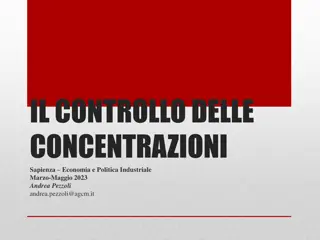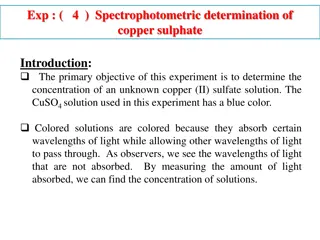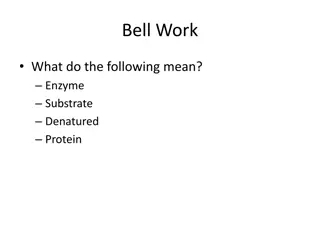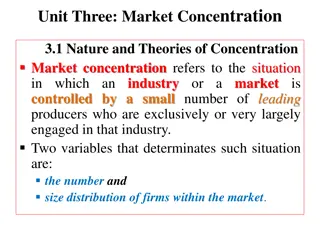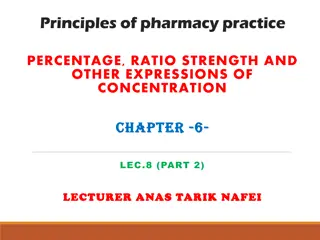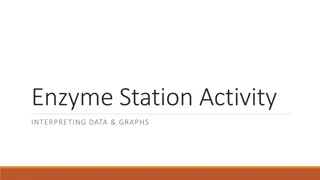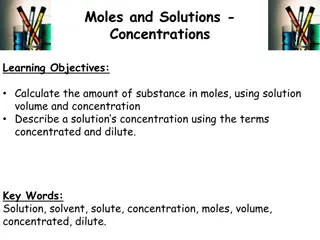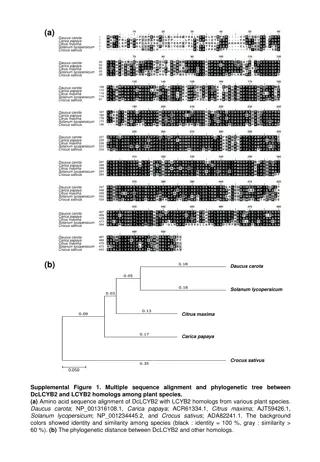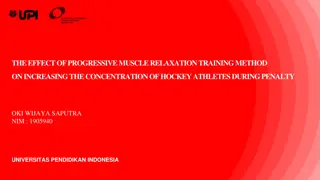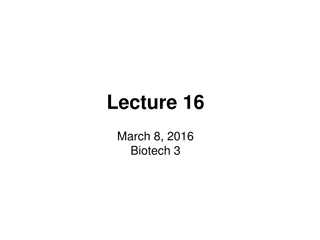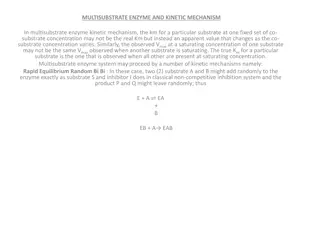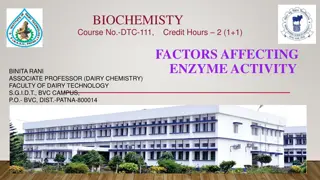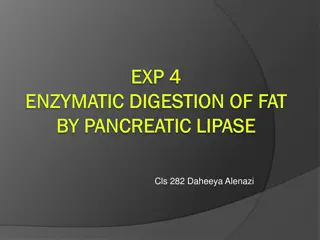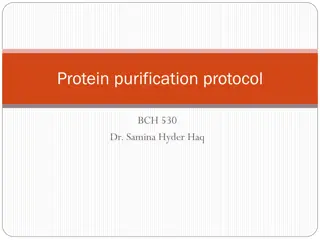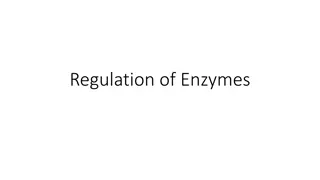Concentration Control in Economics and Industrial Policy
Explore the topic of concentration control in economics and industrial policy, covering recent developments, horizontal and non-horizontal mergers, market power of digital platforms, post-merger evaluations, and calls for stricter merger regulations. Empirical evidence indicates a rise in market con
1 views • 75 slides
Spectrophotometric Determination of Copper Sulfate Concentration
The experiment aims to determine the concentration of an unknown copper (II) sulfate solution by measuring light absorption at different wavelengths. Colored solutions absorb specific light wavelengths and appear colored to our eyes. By creating a calibration curve and following Beer's Law, the conc
3 views • 8 slides
Understanding the Role of Phosphatase Enzymes in Metabolic Reactions
Phosphatase enzymes play a crucial role in various metabolic processes by releasing phosphate groups, increasing their availability for energy synthesis and cell structure formation. Acid phosphatases, with an optimum pH below 7.0, can be extracted from plant tissues like germinating mung beans. A p
7 views • 34 slides
Understanding Enzyme Function Through Induced Fit Model
The learning content discusses enzymes as biological catalysts that increase reaction rates by lowering activation energy. It explores how enzyme activity efficiency is influenced by factors such as temperature, pH, and substrate concentration. The Induced Fit Model is analyzed to explain how enzyme
5 views • 12 slides
Understanding Water Potential and Solute Concentration in Biological Systems
Explore the concept of water potential and solute concentration in cells through diagrams and equations. Learn about hypertonic, hypotonic, and isotonic solutions, and how water movement is affected by solute concentration differences. Discover how adding solutes affects water potential and the dire
0 views • 19 slides
Investigating the Impact of Pineapple Enzyme Bromelain on Gelatin and Pasteurization Process
Explore the effects of pineapple enzyme bromelain on gelatin and how pasteurization can alter its effectiveness in this lab experiment. Discover the different outcomes when using fresh versus canned pineapple and formulate hypotheses to guide the investigation. Follow step-by-step procedures to test
0 views • 15 slides
Factors Affecting Enzyme Activity and Catalysis
Enzyme activity is influenced by various factors such as enzyme concentration, temperature, pH, substrate concentration, inhibitors, activators, and physical agents. The rate of enzyme-catalyzed reactions is directly proportional to enzyme concentration, and temperature plays a significant role with
0 views • 23 slides
Understanding Enzyme Function: The Key Steps and Importance of Cofactors
Enzymes play a crucial role in catalyzing biochemical reactions by forming enzyme-substrate complexes and facilitating changes in substrate molecules to product molecules. The process involves four steps: proximity of enzyme and substrate, binding at the active site, catalysis leading to substrate a
0 views • 39 slides
Understanding Market Concentration and Its Implications
Market concentration refers to industries controlled by a small number of leading producers, impacting pricing and output decisions. Various theories, measurement methods, and implications on firm behavior and performance are discussed, highlighting the relationship between monopoly power and market
0 views • 62 slides
Understanding Peroxidase Enzyme Activity in Biological Samples
Demonstrating the enzyme activity of peroxidase, an enzyme that plays a crucial role in breaking down hydrogen peroxide in various organisms. Learn about the differences between peroxidase and catalase, the calculation of enzyme activity, and the significance of extinction coefficient in enzyme assa
0 views • 8 slides
Understanding Temperature Effects on Donor and Acceptor Ionization in Semiconductors
Temperature plays a crucial role in the ionization of donor and acceptor atoms in semiconductors. In N-type semiconductors, the Fermi level lies below the conduction band, while in P-type semiconductors it lies above the valence band, with the position depending on temperature and impurity atoms. Do
1 views • 13 slides
Exploring Enzyme Kinetics for Understanding Chemical Reactions
Enzyme kinetics is a vital discipline focusing on the rate of enzyme-catalyzed reactions and how they respond to varying conditions. Reactions are classified based on reactant concentration influences. Zero, first, second, and third order reactions are distinguished, with examples like first-order r
0 views • 31 slides
Pharmacy Concentration Expressions Explained
Learn about percentage, ratio strength, and other expressions of concentration in pharmacy practice. Explore how to convert between different concentration units with examples and understand parts per million and parts per billion measurements.
0 views • 17 slides
Demonstration of Salivary Amylase Enzyme Action in B.Sc. Practical
Salivary amylase, an enzyme found in saliva, partially hydrolyzes starch into maltose. This practical involves observing the action of salivary amylase on starch, demonstrating how starch is broken down into glucose and maltose. The procedure includes preparing solutions, collecting saliva, mixing w
0 views • 5 slides
Understanding Kinetics and Reaction Rates in Chemistry
Kinetics is the study of reaction rates and factors affecting them, such as concentration, temperature, catalysts, and more. Orders of reaction classify reactions based on rate dependency on reactant concentration. Factors like pH, light, and solvents can also impact reaction rates. Half-life and sh
0 views • 18 slides
Enzyme Immobilization: Techniques and Applications in Industry and Healthcare
Enzyme immobilization involves confining enzymes on inert supports for stability and reuse, enhancing efficiency and cost-effectiveness. Historical events and examples illustrate various methods and applications. Chemical modifications, such as PEG addition, have shown increased enzyme activity. The
0 views • 34 slides
Understanding Pharmaceutical Preparations: Strength and Concentration
Pharmaceutical preparations can have their strength and concentration adjusted by changing the proportion of active ingredients. This process involves increasing or decreasing the active ingredient, adding diluents, admixing with other preparations, or evaporating the vehicle. Dilution of liquid, so
0 views • 34 slides
Factors Affecting Enzyme Activity and Kinetics Experiments
Explore the factors influencing enzyme activity, such as substrate and enzyme concentration, temperature, pH, and inhibitors. Learn how to simulate enzyme kinetics using equipment like popping beads and stopwatches. Analyze results to understand the impact of substrate concentration on reaction rate
0 views • 22 slides
Understanding Enzyme Activity and Optimal Conditions
This interactive content provides a detailed exploration of enzyme activity through data interpretation and graph analysis. Questions range from identifying the impact of enzymes on specific molecules to determining optimal conditions for various enzyme functions such as pH and temperature. Users de
0 views • 16 slides
Understanding Concentration in Solutions
Solutions involve the dissolution of solutes like salt or sugar in solvents such as water, resulting in different concentrations. This concentration can be expressed as moles per liter, known as molarity. By calculating the amount of substance in moles using solution volume and concentration, you ca
0 views • 8 slides
Immobilization of Enzymes in Biochemistry
Enzyme immobilization involves confining enzyme molecules to a distinct phase from substrates and products, attaching them to solid matrices for enhanced specificity and reduced inhibition. Inert polymers or inorganic materials are used as carrier matrices with methods like physical adsorption onto
0 views • 24 slides
Understanding Quantitative Aspects of Drug Action
Explore the quantitative aspects of drug action, including drug receptor binding, concentration binding curves, dose-response curves, and types of antagonism. Learn to relate drug concentration to receptor binding capacity and response produced. Discover how concentration binding curves and dose-res
0 views • 29 slides
Understanding Enzyme Inhibition in Biochemistry
Enzyme inhibition plays a crucial role in pharmacology and biochemistry by regulating enzymatic reactions. Inhibitors can be reversible or irreversible, affecting enzyme activity differently. Competitive, uncompetitive, and noncompetitive inhibition types are explained along with examples like diiso
0 views • 20 slides
Plant Enzyme Activities and Phylogenetic Analysis
The content discusses the alignment of various plant enzyme amino acid sequences, including DcLCYB1, DcLCYB2, and DcLCYE, among different inbred lines. It also explores the construction of DcLCYs for enzyme activities using an E. coli complementation assay. The phylogenetic relationship between DcLC
0 views • 5 slides
Enhancing Memory and Concentration Techniques for Academic Success
Explore the fascinating world of memory and concentration through various techniques and processes highlighted in the provided images. Discover how sensory memory, short-term memory, and long-term memory function, along with tips on improving concentration, learning strategies, and the interplay bet
1 views • 34 slides
Demonstration of Salivary Enzyme Amylase Action in B.Sc. Practical
Salivary enzyme amylase, also known as ptyalin, plays a crucial role in breaking down starch and glycogen into maltose. This practical session in the Zoology department explores the action of salivary enzyme amylase at a temperature of 37°C and pH of 6.6. By conducting experiments with starch, iodi
0 views • 8 slides
Understanding Acid-Base Titration in Chemistry
Acid-base titration is a quantitative technique used to determine the concentration of unknown acids or bases. Through neutralization reactions, the concentration of a solution can be calculated based on the stoichiometry of the reaction. This method dates back to the late 18th century and is crucia
0 views • 24 slides
Free from Regret: Transitional Stage in Buddhist Concentration Practice
Exploring the transitional stage between la and Samdhi Sun, this workshop delves into the multiple prerequisites for Buddhist concentration (samdhi) and the shared inner states that foster concentration. By overcoming the Five Hindrances, practitioners can achieve joy, rapture, tranquility, and ulti
0 views • 22 slides
The Impact of Progressive Muscle Relaxation Training on Hockey Athletes' Concentration During Penalties
Concentration is crucial for athletes, especially during penalties in hockey. Progressive Muscle Relaxation training can enhance concentration by requiring players to focus while relaxing. This study aims to investigate the effectiveness of PMR on improving hockey athletes' concentration during pena
0 views • 12 slides
Understanding Enzyme Assays in Biotechnology
Exploring enzyme assays in biotechnology, covering topics such as ELISA, protein assays, enzyme activity measurement techniques, specific activity, terminology related to enzyme assays, and different types of experiments conducted by biochemists to study enzyme-catalyzed reactions. The content delve
0 views • 53 slides
Cyanide's Impact on Respiration Through Enzyme Inhibition
Cyanide, a noncompetitive inhibitor of the enzyme cytochrome c oxidase, disrupts electron transport in respiration by binding to the iron cofactor and blocking electron transfer to oxygen. This lethal effect was utilized in gas chambers during WWII, underscoring the crucial role of enzyme function i
0 views • 7 slides
Understanding Multisubstrate Enzyme Kinetic Mechanisms
In multisubstrate enzyme kinetic mechanisms, the apparent Km and Vmax values change with varying substrate concentrations. Different kinetic mechanisms like rapid equilibrium Bi Bi and ordered Bi Bi reactions can occur. The ping-pong Bi Bi reaction involves oscillation between enzyme forms. Various
0 views • 11 slides
Factors Affecting Polyphenol Oxidase Activity in Enzyme Reaction
Polyphenol oxidase (PPO) is a copper-containing enzyme with an optimal pH of 6.7 that catalyzes the oxidation of phenols, leading to color changes like browning in fruits and potatoes. This experiment aims to demonstrate PPO activity, its chemical nature, substrate specificity, and the effects of te
0 views • 18 slides
Understanding Factors Affecting Enzyme Activity in Biochemistry
Enzyme assays measure substrate conversion to product under varying conditions like cofactors, pH, and temperature. Enzyme velocity represents the rate of a catalyzed reaction, typically reported as V0. Enzyme activity is expressed as mol of substrate transformed per minute, with enzyme unit and kat
0 views • 18 slides
Enzymatic Digestion of Fat by Pancreatic Lipase
The experiment focuses on studying the enzymatic digestion of fat by pancreatic lipase. It covers the structure of triglycerides, the role of lipase enzyme in hydrolyzing triglycerides to release fatty acids, and the general hydrolysis process. The aim is to investigate the effects of lipase enzyme
0 views • 9 slides
Understanding LacZ - Galactosidase Enzyme: Structure, Function, and Applications
LacZ - galactosidase enzyme, encoded by the lacZ gene in the lac operon, plays a crucial role in cleaving lactose, transgalactosylation, and regulating gene expression. Its application in labs using X-gal as a substrate allows for easy detection of active enzyme through color changes. This versatile
0 views • 13 slides
Understanding Concentration and Solubility in Solutions
This content covers topics related to concentration and solubility in solutions, including calculating concentration, determining solubility, and comparing different solution properties based on concentration levels. It also includes examples and explanations to help understand these concepts better
0 views • 6 slides
Protein Purification Protocol: Practical Training in Biochemistry Techniques
This protein purification protocol course, led by Dr. Samina Hyder Haq, focuses on practical training in various biochemistry techniques. The course covers organizing experimental protocols, protein isolation strategies, sequential enzyme purification, enzyme kinetics, and writing scientific reports
0 views • 25 slides
Understanding Enzyme Regulation and Factors Affecting Enzyme Activity
Organisms carefully control enzyme production and activation as per varying needs and conditions within cells. Enzyme activity is influenced by factors such as pH, temperature, regulatory molecules, cofactors, compartmentalization, covalent modification, and feedback inhibition. Enzymes can be regul
0 views • 20 slides
Understanding Solution Concentration: Lesson in Chemistry
Explore the concept of solution concentration through an engaging experiment involving gummy bears in sugar and water solutions. Learn about key terms such as solution, solute, solvent, saturated solution, concentration, and molarity. Discover how molecules move based on concentration gradients and
0 views • 10 slides
